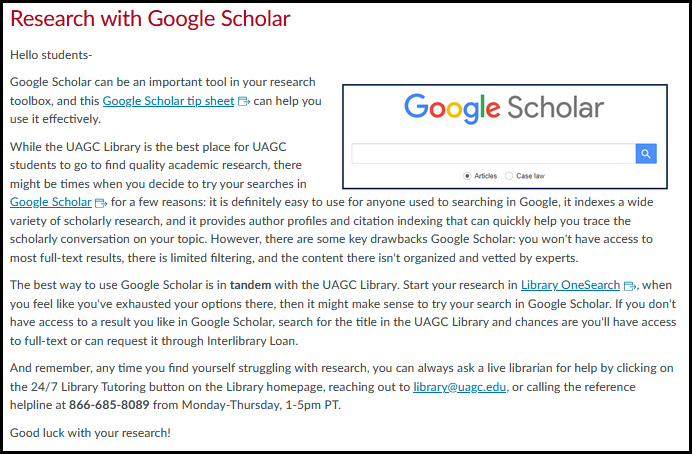

While the UAGC Library is the best place for students to find scholarly research, there may be times when they want to use Google Scholar to cast a broader net. Use this HTML announcement to explain to students some of the pros and cons of Google Scholar and provide them with a tip sheet to make their searches more efficient.
To post the below announcement in your class or as part of your instructor guidance, create a new announcement, and click on the “HTML Editor.” Add the title, Research with Google Scholar, then copy and paste the HTML code from the last page of this document.


Subject: Research with Google Scholar
<p>Hello students-</p> <p><img style="float: right;" src="/users/126656/files/22146328/preview?verifier=pLTlJdg6KTirRAElomInhs0rSwbFnnLnuZZFMejM" alt="google scholar search box with radial button selecting default articles search" width="458" height="155" /></p> <p>Google Scholar can be an important tool in your research toolbox, and this <a class="inline_disabled" href="https://content.bridgepointeducation.com/curriculum/file/e9468598-c099-4b7f-8aa5-06da5e74a447/2/Google_Scholar_Tip_Sheet.pdf" target="_blank" rel="noopener">Google Scholar tip sheet</a> can help you use it effectively<span style="color: var(--ic-brand-font-color-dark); font-family: inherit; font-size: 1rem;">. </span></p> <p>While the UAGC Library is the best place for UAGC students to go to find quality academic research, there might be times when you decide to try your searches in<span style="color: var(--ic-brand-font-color-dark); font-family: inherit; font-size: 1rem;"> </span><a class="inline_disabled" style="font-family: inherit; font-size: 1rem;" href="http://scholar.google.com" target="_blank" rel="noopener">Google Scholar</a><span style="color: var(--ic-brand-font-color-dark); font-family: inherit; font-size: 1rem;"> for a few reasons: it is definitely easy to use for anyone used to searching in Google, it indexes a wide variety of scholarly research, and it provides author profiles and citation indexing that can quickly help you trace the scholarly conversation on your topic. However, there are some key drawbacks Google Scholar: you won't have access to most full-text results, there is limited filtering, and the content there isn't organized and vetted by experts.</span></p> <p>The best way to use Google Scholar is in <strong>tandem</strong> with the UAGC Library. Start your research in <a class="inline_disabled" href="https://ashford.mediaspace.kaltura.com/media/How+To+Use+FindIt%40AU/0_sijzep60" target="_blank" rel="noopener">Library OneSearch</a>, when you feel like you've exhausted your options there, then it might make sense to try your search in Google Scholar. If you don't have access to a result you like in Google Scholar, search for the title in the UAGC Library and chances are you'll have access to full-text or can request it through Interlibrary Loan.</p> <p>And remember, any time you find yourself struggling with research, you can always ask a live librarian for help by clicking on the 24/7 Library Tutoring button on the Library homepage, reaching out to <a href="mailto:library@uagc.edu," target="_blank" rel="noopener">library@uagc.edu,</a> or calling the reference helpline at <strong>866-685-8089 </strong>from Monday-Thursday, 1-5pm PT.</p> <p>Good luck with your research!</p>